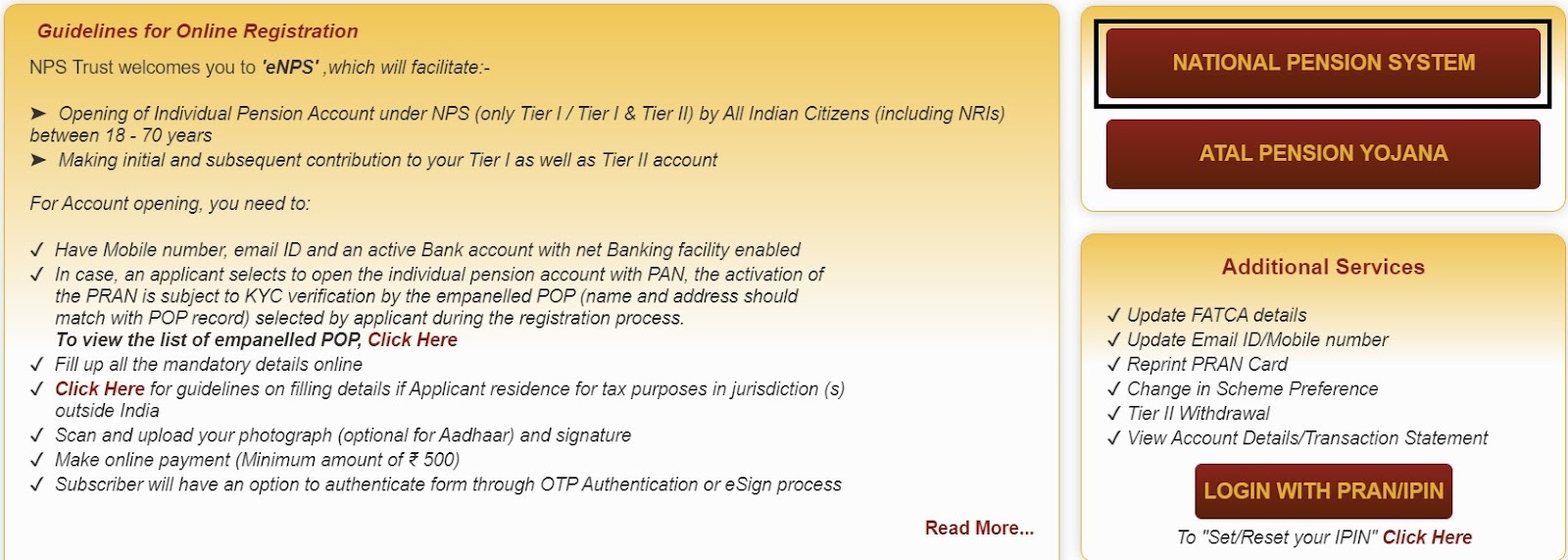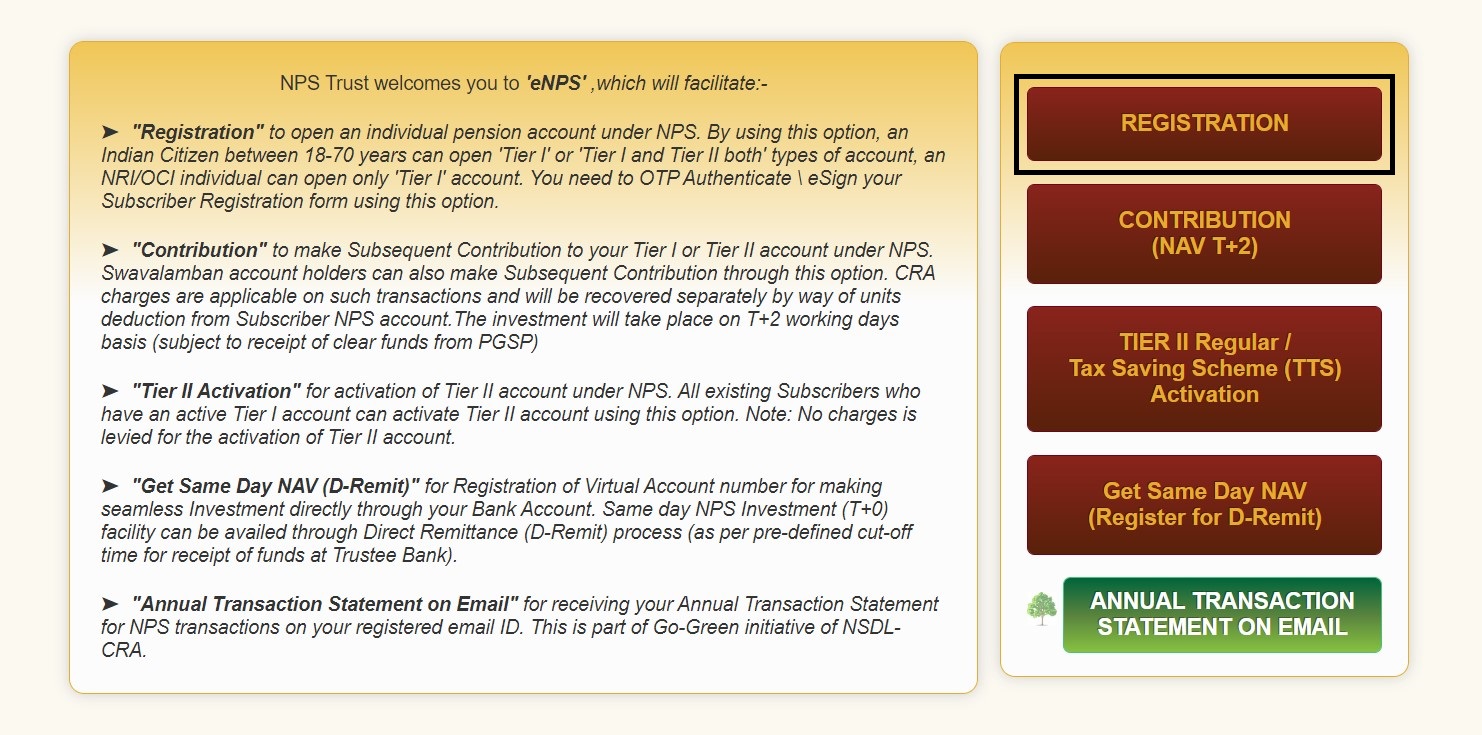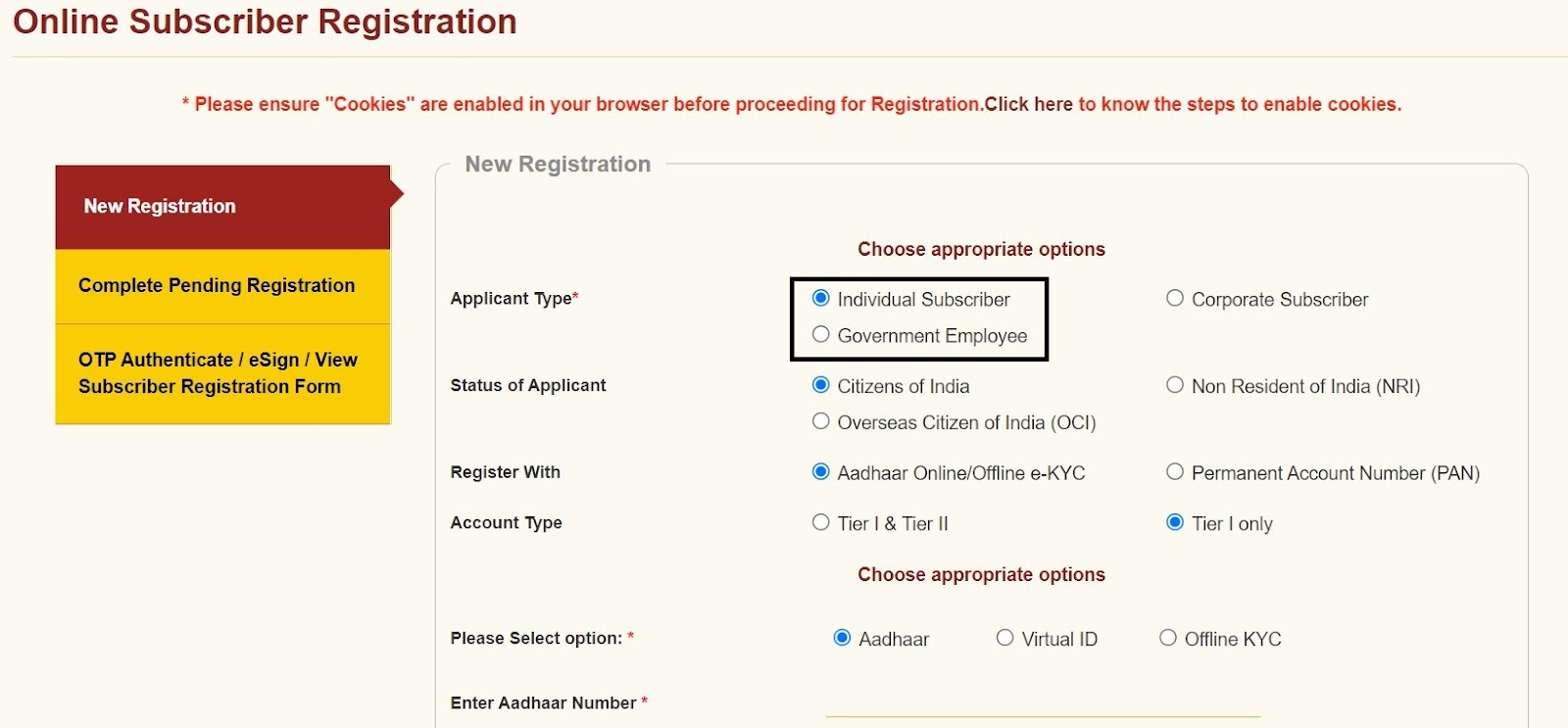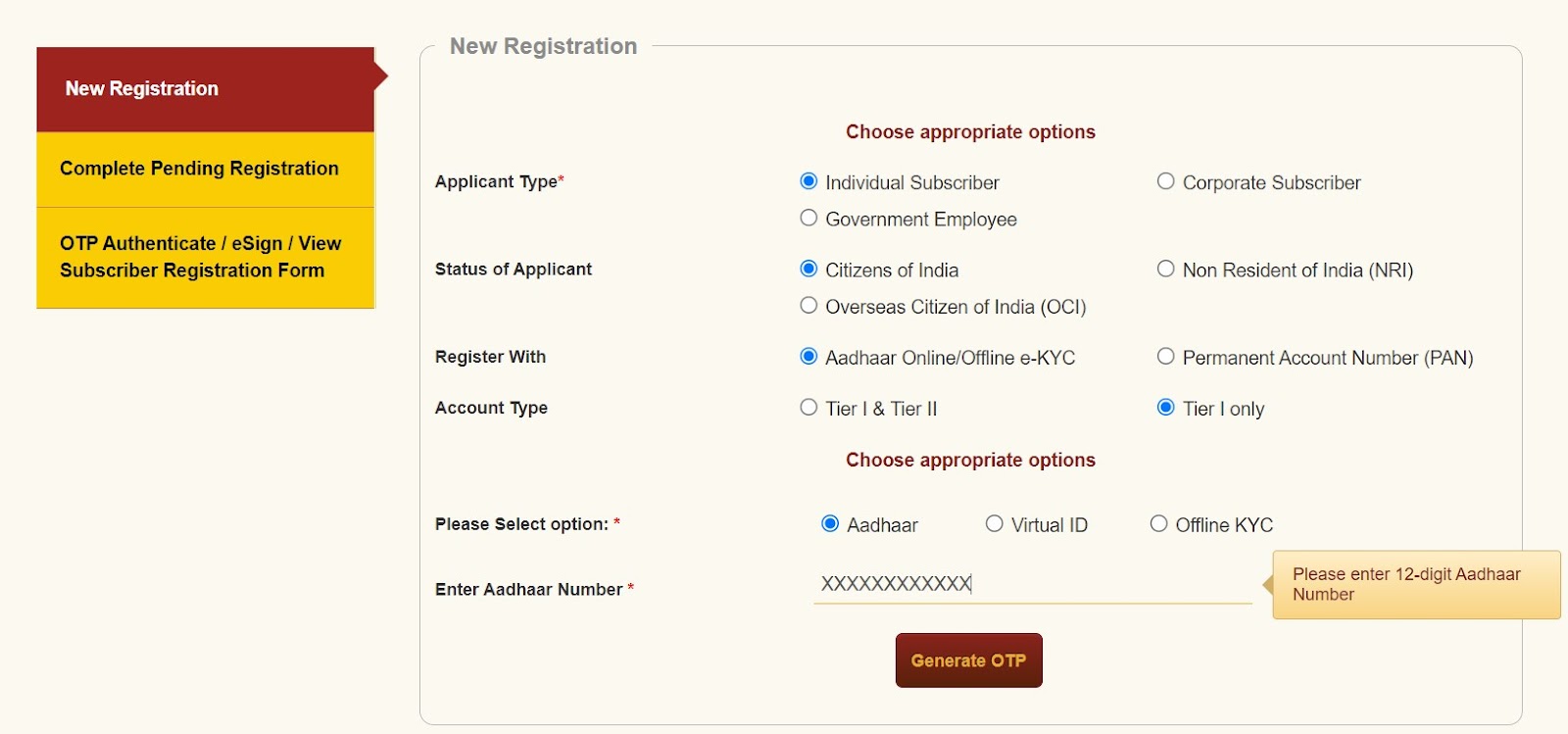How to Open an NPS Account Online and Offline?

National Pension Scheme
The National Pension Scheme (NPS) is a voluntary retirement savings scheme for citizens of India between the ages of 18 and 60. It offers two types of accounts: Tier I and Tier II. Tier I is mandatory and offers tax benefits, but withdrawals are restricted. Tier II is voluntary and allows withdrawals without restrictions, but contributions are not eligible for tax benefits. Subscribers can choose their investment mix based on their risk appetite and investment objectives. At retirement, subscribers can withdraw up to 60% of their accumulated corpus in a lump sum and must use the remaining 40% to purchase an annuity from a PFRDA-registered life insurance company.
How to Open an NPS Account Online?
You can open NPS account online by following the steps below :
- Visit eNPS portal
Navigate to the official eNPS portal. Click on ‘Click Here for Registration of Virtual ID (VID) for making same-day Investment directly through your Bank Account under NPS’.

- Click on ‘Registration’.
A pop-up window will appear. Select ‘Registration’

- Select Individual Subscriber
From the Applicant Type category, select ‘Individual Subscriber.’

- Select residential status
Depending on your current residential status, choose one of the three options — Indian citizen, Non-resident Indian, or Overseas Citizen of India. Next select ‘Aadhaar Online/Offline e-KYC’. Select the appropriate Tier and Aadhaar. By default, all NPS account holders have a Tier I account

- Generate OTP
Next, enter your Aadhaar number and the 16-digit Virtual ID in the relevant fields. After entering these two numbers, click on generate OTP. Enter the received OTP in the correct space and hit continue.
- Fill out the PRAN Form
After successful OTP verification, the online PRAN form will appear with details, such as date of birth, full name, gender and residential address already filled up. You would still need to provide other relevant information during this stage of the application.
- Make an account opening contribution
Make an initial contribution to the account to validate your National Pension Scheme account.
- Complete e-signature
The last step involves a digital authentication procedure which you can complete using an Aadhaar-based e-signature.
How to Apply for an NPS Account Offline
Follow the steps below to apply for an NPS Account Offline
Step 1: Visit any PoP entity and ask for a PRAN form.
Step 2: After filling up this application form, submit the same. Substantiate your application by submitting relevant documents too.
Step 3: Pay the registration fee at the bank branch after the submission of your form.
After a few days, you would receive the PRAN card through the post at your residential address. As you can see, this offline process can be cumbersome and time-consuming. It requires you to visit the bank branch and wait for PRAN authentication. The online process eliminates much of this hassle.
Also Read
Types of NPS Account
The National Pension Scheme (NPS) offers two types of accounts: Tier I and Tier II.
Tier I account is a mandatory account for all subscribers and is designed to provide a retirement benefit. Contributions made towards this account are eligible for tax benefits under Section 80CCD of the Income Tax Act. However, withdrawals from this account are restricted and are allowed only upon retirement or in exceptional circumstances such as terminal illness or death.
Tier II account is a voluntary savings account that allows subscribers to withdraw their savings at any time without any restrictions. However, contributions to this account are not eligible for tax benefits. This account can be opened only if the subscriber has an active Tier I account.
Benefits of Opening an NPS Account with Aadhaar
1. It is Voluntary
A subscriber may contribute at any time during the fiscal year and change the amount he wishes to set aside and save each year.
2. It’s Simple
The subscriber must open an account with any of the POPs (Points of Presence) or via eNPS .
3. It is Adaptable
Subscribers can select their own investment options and pension fund and watch their money grow.
4. It is Portable
Subscribers can access their accounts from anywhere, even if they change cities or jobs.
5. It is Regulated
NPS is governed by the PFRDA, with transparent investment guidelines and regular monitoring and performance evaluations of fund managers conducted by the NPS Trust.
How to Check NPS Account Statements?
Log in to your account using the login id and password provided by CRA with your PRAN Kit.
The respective CRA will print and mail a Statement of Transaction (SOT) for your NPS account once a year to your registered address. A soft copy will also be sent to your registered email address on a regular basis.
Subscribers can now download their Statement of Transactions online at any time.
How to Close Your NPS Account?
You can exit from NPS anytime, if you do not wish to continue it.
Step 1: Log in to CRA system using your User ID (PRAN) and Password.
Step 2: Click on “Exit from NPS” menu and click on “Initiate Withdrawal request” option.
Step 3: Enter necessary details including choice of Annuity Service Provider (ASP) and Annuity Scheme which will provide you pension.
Step 4: After submitting the details, you have to print the system generated Withdrawal form, paste photograph, sign across photograph and against the declaration and submit the form along with KYC documents to respective Nodal Office, in case of Government sector and from Point of Presence (POP), in case of All Citizens of India & Corporate sector.
Step 5: The Nodal Office will verify the form along with the attached documents and authorized the withdrawal request online in CRA.
How to Unfreeze Your NPS Account?
You can unfreeze your NPS Account through online, you can either login to or your account or open the NPS application and make a minimum contribution of Rs.1000 to the NPS and your account will be unfreezed instantly.
Final Word
The National Pension Scheme (NPS) is a beneficial retirement savings. Opening NPS Account can help you improve your financial well-being after retirement as it offers tax benefits, investment flexibility, and a regular income stream through annuity purchase upon retirement. After reading the entire blog, we hope you know how to open NPS account.
Also, if you’re looking for tax-saving options on investments, here’s an interesting opportunity for you. Invest in Navi Mutual Fund’s ELSS Tax Saver Nifty 50 Index Fund and save up to ₹46,800 in taxes. But there’s more – the fund lets you capture the growth of top 50 Indian companies! Download the Navi app and start investing today.
FAQs
Aadhaar eKYC for NPS account is only possible after OTP verification. If your mobile number is not linked to your Aadhaar, you will not receive an OTP. Hence, an online NPS account opening using Aadhaar would be impossible under such a circumstance.
The Pension Fund Regulatory and Development Authority (PFRDA) issued a press release regarding this matter on April 27 2021. In it, the government body authorised financial institutions to onboard new NPS clients using the Aadhaar online KYC process.
If you opt for an offline NPS application, you would need to pay a fee to the PoP bank you choose. The initial subscriber registration fee is Rs. 200. Remember that the bank will collect this fee upfront.
Tier-I subscribers must make a minimum initial contribution at the time of registration. They must pay a minimum of Rs. 500 per contribution in NPS. In a particular financial year, the contribution to the account cannot be less than Rs. 1000.
Note that Indian citizens who are aged between 18 and 60 years can open an NPS account. While the account matures when subscribers turn 60, they can choose to extend the investment until they are 70.
Aadhaar Enrolment Centres in Your City

Types of Fixed Deposit in 2023 – Know Different Types of FDs and How to Choose
Fixed deposits (FDs) are a popular investment option offered by banks and other financial instituti... Read More »10 Best National Pension Schemes (NPS) in India in April 2023
National Pension Scheme (NPS) is a retirement benefits scheme launched by the Government of India f... Read More »National Pension Scheme (NPS) – How to Open NPS Account?
National Pension Scheme or NPS is a voluntary contribution-based retirement benefits scheme introdu... Read More »Mahila Samman Savings Certificate Scheme -Interest Rate, Benefits and Eligibility
The Mahila Samman Savings Certificates, a fixed-income investment programme explicitly launched for... Read More »What is a Tax Saving FD – Interest Rates, Benefits, Features and Calculation
Did you know that tax-saving FDs (fixed deposit) can help you save up to Rs.46,800 on taxes? Consid... Read More »What is Fixed Deposit – Best FD Interest Rates, Calculations and How to Apply Online
Fixed deposits (FDs) are known to offer guaranteed returns - one of the reasons why they are so pop... Read More »EPF Interest Rate 2023 – 8.15% FY 2022-23
The Employee Provident Fund (EPF) is a Government-backed retirement savings scheme directed towards... Read More »12 Best Investment Plans in India in April 2023 – Returns & Benefits
Working extra hard to earn money? Great! But, how about making your money work as well? Yes, we are... Read More »Sukanya Samriddhi Yojana: Bank Interest Rates and How to Open a SSY Account
Honourable Prime Minister Narendra Modi launched SSY (full form - Sukanya Samriddhi Yojana) as an i... Read More »Senior Citizen Savings Scheme (SCSS) – Interest Rate 2023
The Senior Citizen Savings Scheme is a government savings scheme launched for the senior citizens o... Read More »List of GST State Codes and Jurisdiction 2023
What is the GST State Code? GST state code is the first two digits of the number on the GS... Read More »Open PPF Account Online and Offline – Features, Documents Required and Benefits
PPF (full form: Public Provident Fund) is a government backed long-term savings scheme that comes w... Read More »Top 10 Chit Fund Schemes in India in 2023
Chit funds are one of the most popular return-generating saving schemes in India. It is a financial... Read More »10 Best Gold ETFs in India to Invest in April 2023
Gold ETFs or Gold Exchange Traded Funds are passively managed funds that track the price of physica... Read More »10 Best Demat Accounts in India for Beginners in 2023
Creation of Demat accounts revolutionised the way trades were conducted at the stock exchanges. It... Read More »20 Best Index Funds to Invest in India in April 2023
What is an Index Fund? An index fund is a type of mutual fund or exchange-traded fund (ETF) that... Read More »Best Arbitrage Mutual Funds to Invest in India in April 2023
Arbitrage funds are hybrid mutual fund schemes that aim to make low-risk profits by buying and sell... Read More »10 Best SIP Plans in India to Invest in April 2023
What is SIP? SIP or Systematic Investment Plan is a method of investing a fixed amount in ... Read More »10 Best Corporate Bond Funds in India to Invest in April 2023
Corporate bond funds are debt funds that invest at least 80% of the investment corpus in companies ... Read More »10 Best Bank for Savings Account in India [Highest Interest Rate 2023]
Savings account is a type of financial instrument offered by several banks. It lets you safely depo... Read More »






















